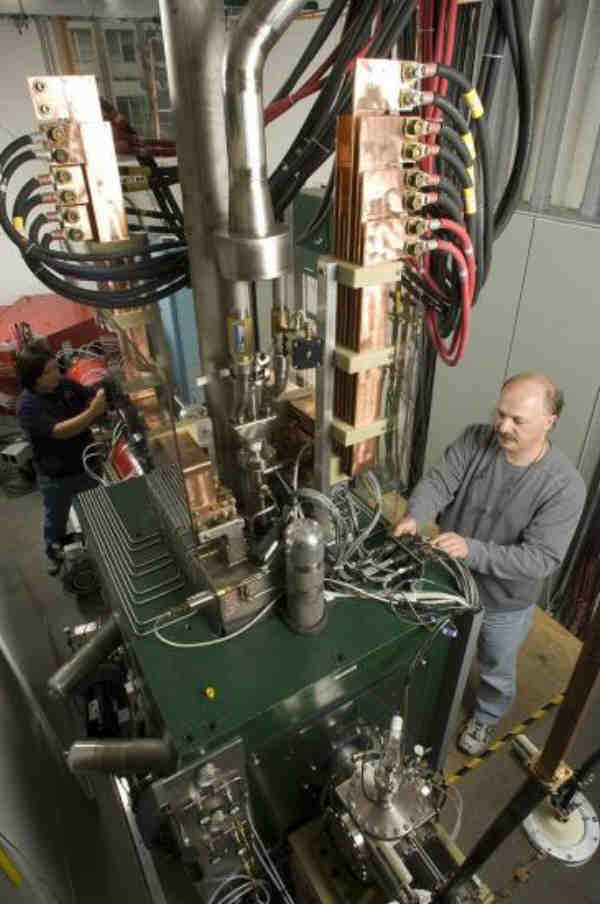
A Michigan State University researcher operates the Superconducting Source for Ions (SuSI), the newest ion source, that uses chilled superconducting magnets to produce an enhanced magnetic field. Hope for Mid-Michigan in a Research Facility for Isotopes at Michigan State
|
||||||||||
| Printer Friendly Story View |
The federal government decision to put a major new research facility in mid-Michigan is the most positive move we can imagine at this crucial time for our economy.
Atomic research at Michigan State University in East Lansing doesn't seem like it will help the family next door replace the job they lost at the auto plant, but there are unseen benefits to this project.
A study by the Anderson Economic Group indicates that the project will create $1 billion in economic activity, new earnings for workers of $446 million during construction, and over $187 million in state tax revenue over 20 years.
That is money coming into our state and region that we otherwise wouldn't have, so we should be grateful for this project.
The new facility will create an international research community of about 1,000 less than 90 miles from the tri-county area. It will also create construction jobs and ongoing administrative and support jobs as well.
But more importantly, a research facility this close will provide immense opportunities for the young people of mid-Michigan. The science-minded graduates of Central, Western, Garber, All Saints, John Glenn, Pinconning, Nouvel, Valley Lutheran, Dow, Midland, Arthur Hill and Saginaw High, and other surrounding schools will be the primary beneficiaries of the future.
"At a moment in our history when Michigan needs signs of hope, the recent decision by the U.S. Department of Energy to build the Facility on Rare Isotope Beams (FRIB) at Michigan State University offers great hope for Michigan's economic future," said U.S. Sen. Carl Levin, Detroit Democrat.
The new government center will study rare isotopes, atoms of a chemical element with differing properties. This will involve a line of nuclear science research that creates atoms that are not normally found on Earth and that have unusual numbers of neutrons. Such atoms are generally only created during dramatic celestial events, such as during the formation of stars in space.
"The research offers enormous promise to help physicists further understand the universe and harness the power of nuclear science for practical applications," said Sen. Levin.
The FRIB facility will be a $550 million project of the Department of Energy (DOE). The DOE estimates that the facility will provide research opportunities for an international community of university and laboratory scientists, postdoctoral associates, and graduate students.
With its world-class National Superconducting Cyclotron Laboratory (NSCL), MSU is already at the forefront of nuclear science research. The NSCL has achieved world renown as hundreds of scientists have used the facility for nuclear physics. It is also widely recognized for the innovations in particle accelerators that have originated there.
NSCL scientists recently have discovered three isotopes by bombarding a tungsten target with a tungsten beam. This was done in an attempt to understand the elements inside the stars and supernovas.
MSU scientists found out that the new isotopes existed for only fractions of second after the atomic collisions. As of now, about 300 stable isotopes exist. Roughly, about 3000 unstable ones are possible.
The research was reported in the journal, Nature. The elements Magnesium, aluminum as well as Carbon have a certain number of protons. There are no good theories as to predict the number of protons. Along with the protons, the neutrons help form the nuclei of any chemical element.
MSU now produces ten percent of our nation's Nuclear Physics doctoral degree graduates. The FRIB will bring additional interest to the university's graduate programs. NSCL educational programs will open the world of nuclear science to students as young as elementary school age.
Discovery possibilities will abound at the new facility. Beyond helping scientists understand the structure of the universe and the origins of matter, rare isotope research can contribute to fields including nuclear physics, astrophysics and biology. And there are potential commercial applications of the research that can be helpful in creating new medical tools and treatments, improving food safety, and helping environmental protection.###
| Printer Friendly Story View |
|
|

Dave Rogers |
|
|
|
Printer-Friendly Story View
0200 Nd: 04-15-2024 d 4 cpr 0
12/31/2020 P3v3-0200-Ad.cfm
SPONSORED LINKS
12/31/2020 drop ads P3v3-0200-Ad.cfm


